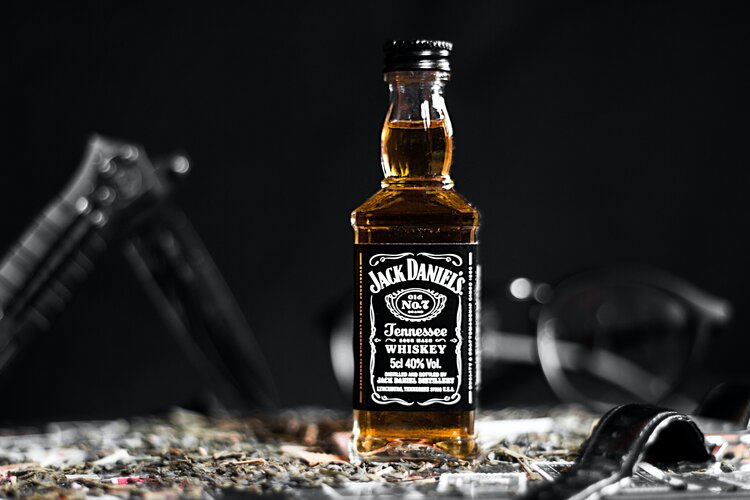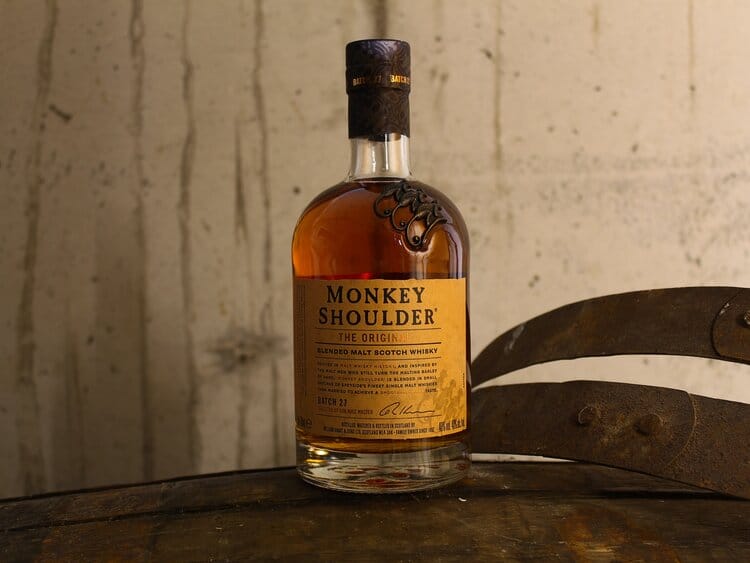
Whiskey is undoubtedly the most popular alcohol, paired with richness and quality, in almost every aspect of this theme. We have compiled for you the journey of whiskey from past to present, how it should be processed and drunk, and the ten best whiskey brands you might want to buy.
What is whiskey?

Whiskey is a dark distilled liquor made from a variety of grains, including barley, corn, rye, and wheat. It is distilled around the world, most popularly in Ireland, Scotland, the United States, Canada and Japan. There are various styles of whiskey, and some countries have regulations that dictate how it is produced. While these regulations vary from country to country, the taste of all types of whiskey differs according to the region, country and place of production.
Recurring in TV shows and movies, Irish whiskey, be it scotch, bourbon or Canadian whiskey, is the world’s most popular liqueur and is used in numerous cocktail and shot recipes. Surprisingly, while the country’s own whiskey is rarely exported, drinkers in India consume the most.
Alcohol ratios of whiskeys in the market generally vary between 40% and 70%. These ratios differ from brand to brand, as well as in different types of whiskey. Many whiskey brands offer products that are separated according to different alcohol ratios and types of production.
What are the calories in a shot of whiskey?
A shot of whiskey contains about 70 calories, although it varies according to the type. There are varieties of whiskeys with different flavors such as oak, grain, vanilla, caramel. This difference is due to the way it is made. Whiskey is a drink that increases in quality and price as it ages, but whiskey ages in a barrel, not in a bottle. Since there is no aging in the bottle, there is no need to store it horizontally, it is even recommended to stand upright. Although 90% of the books, blogs, articles and tasting notes written on whiskey are on malt whiskeys, 90% of the world whiskey sales are blend whiskeys.
Whiskey can be served in different ways, these services vary according to one’s own taste. It has different types of serving such as “straight”, “on the rocks”, “with a twist”. Apart from that, it can be used as a cocktail and shot drink. For most cocktails, whiskey is an indispensable alcohol.
history of whiskey

The ancient Egyptians already knew the principles of distillation. However, they distilled perfume, not drinkable alcohol. We still don’t know if any priests at that time knew about the distillation of potable alcohol.
With the rise and fall of the Greek and Roman Empires, the knowledge of distillation was lost. The dominant alcoholic beverage of that time was almost self-produced wine. It ripened well in the Mediterranean sun and fermentation required little attention.
In the cold north of the Alps, these things were not so easy. The Romans brought us the art of making wine, but its alcohol content was limited, as the lack of sunlight led to its low sugar content. Instead, the acid content was too high, and many medieval knights and nobles suffered from various ‘body stones’ caused by their high consumption of wine. These stones, which can be up to the size of a fist, can still be found in medieval tombs today.
Ancient knowledge fell into obscurity in the Middle Ages, and only in monasteries the achievements of the Egyptians, Greeks and Romans on alcohol distillation were preserved. The enormous expansion of Rome led to the displacement of the Celts. Originally based in Bavaria, they had to surrender to the superpower and retreat more and more to the northwest. Therefore, 11. It is hardly surprising that it was Celtic priests who brought the art of distillation on their long journey to Ireland in the 19th century.
Hardly any wine grows on this rainy, stormy island. People had to make do with beer made from fermented barley. Barley is the only grain that contains enough enzymes that break down starch into sugar and then fermented by yeast. This was not possible with domestic oats.
First Appearance of Whiskey:
But after a few hundred years of cultivation, barley yielded well, and whiskey was first mentioned in a Scottish document in 1494. Bushmills was the first documented distillery in Ireland in 1608. However, wine was distilled on the continent, with the leading producers being the French in the Cognac region. All the royal houses in Scotland and Ireland bought cognac from France.
Insects damaging grapevines, 18. It spread to France at the end of the century. The pests multiplied non-stop within a few years, destroying more than 50% of the wine harvest in the Cognac region. But an imaginative Scotsman had a brilliant idea. Why didn’t they store the whiskey in used sherry barrels as it is made with cognac? These casks were already in place to store the whiskey after the sherry was empty. At best, the sherry flavor in whiskey would lead to a cognac-like flavor.
The success was overwhelming and with the advancing industrialization and mechanical production of the glass bottle, whiskey began its global success story. We owe the whiskey bottle in our living room to the ancient Egyptians, Celtic priests, and an unknown, resourceful Scotsman.
What are the preferred formats for whiskey orders?
So how to order whiskey in a bar? In short, you can order as you wish. Plain, frosted, blended, whatever you want at the end of the day. Of course, if you want to look like a pro when ordering, here are 11 terms you can use to order at a bar or lounge:
1) On the rocks:
Whiskey is served with ice.
2) Neat:

Whiskey is served without ice.
3) Up:
Mixed with ice and then strained into a pre-chilled cocktail glass (this format is convenient if you order a whiskey-based martini like Manhattan)
4) With a twist:
Served with a thin strip of citrus peel (usually lemon or orange), this strip is twisted and pressed into the whiskey glass.
5) Lemon
Served with a glass of lemon or lime slice.
6) Shake:
Shaken actually means shaken when we translate it into Turkish. It’s usually made when you order cocktails with juice, egg whites, and other non-carbonated ingredients. This helps bring the ingredients together and add air to the cocktail.
7) Stirred:
Stirred means mixed. It is usually preferred when you order a cocktail made only with spirits, sweeteners and/or spices.
8) Cask Strength:
Whiskey is usually much stronger in terms of alcohol content (like 60-90%) in the barrel. Water is often added to reduce the whiskey to 40-50%, although some rare whiskeys are sold in cask strength.
9) Chaser:
It is the general name given to a juice, soda or other beverage that is drunk immediately after a shot. Although there is no word that fully corresponds to its meaning in Turkish, it is very similar to the logic of polish.
10) Short:
When ordering a double, if you want less mix, specify that you want it to be short. Double means twice the normal amount of whiskey.
11) Drama:
Traditional Scottish saying for a glass of whiskey.
How Is Whiskey Made?

It comes from the Welsh uisge, a shortened version of uisge beatha, also known as aqua vitae in Latin, meaning “water of life.” Whiskey was used as a medicine in ancient times and was preferred by healers both as an internal anesthesia and as an external antibiotic.
Distillation techniques were brought to Scotland and Ireland by priests at an unknown date between 1100 and 1300. Since wine could not be easily obtained due to the geographical conditions in that land, barley beer was distilled into a liquor and whiskey emerged. Production of distilled spirits 15. Until the 19th century, it was limited to pharmacies and monasteries. Whiskey reached North America with Irish and Scottish immigrants and then spread around the world.
Although slightly different methods are used in different types of whiskey, in essence, they are all made in the same way. Whiskey, like beer, is originally a mixture of grains – which, as we mentioned earlier in the article, are usually barley, corn, wheat or rye. Some types can be malted just as in beer. Grains are mixed with water and yeast to ferment, which causes the starch to turn into alcohol. Next, the beer is passed through a retort—either pottery distillation or continuous column distillation—that heats the liquid with a concentrated vapor. It exits the other end as a clear, high-quality liquid distillate.
Almost all whiskey is then aged in barrels for at least a few years. This imparts aromas of oak and wood, thickens the liquor and softens hard alcohol. After the cask, the whiskey is then mixed with other casks or different styles of whiskey and often diluted to bottling strength. Whiskey is typically bottled at 40 percent alcohol by volume or slightly higher. Some undiluted cask strength whiskeys can reach a seventy percent alcohol rating.
What does whiskey taste like?

Let’s start with the bad news: because the whiskey world is so diverse, it’s impossible to give a definitive answer about whiskey taste. The biggest reason for this is that there are dozens of different types of whiskey and each offers a completely different sensory experience.
How can two bottles of whiskey taste so different? Whiskey has one of the widest flavors of any spirits, due to so many variables in its production. It can be made from any grain on any type of distillation. Cereals may be smoked or uncured. Distillers can use any type of yeast and a wide variety of barrels.
Still, some similarities can still be noticed between the various different styles. This is because many aspects of a whiskey flavor can share up to one of the following three factors shared by all whiskeys:
- Grain
All whiskey is made from grain. But any grain can be used to make whiskey, from traditional options like corn, rye or malted barley to thousands of different local grains.
But the flavors of the grain are only part of what makes up a whiskey’s final flavor. How these grains are fermented, distilled, and aged will transform their basic flavor characteristics into a much more complex experience.
- fermentation and distillation
Fermentation and distillation are not just ways to produce and concentrate alcohol. They’re also important flavor-add steps on their own.
Different yeasts and fermentation strategies can create different flavor experiences in whiskey, from dry and spicy to richly fruity and perfumed.
- Barrel
Distillers around the world agree that oak is the best wood for aging whiskey. This is because of the flavor it adds to the whiskey. It is packed with compounds that evoke the classic whiskey flavor, such as oak, caramel, vanilla, toasted almonds, coconut, maple syrup.
American oak tends to be sweet and spicy and imparts whiskey flavors such as nutmeg, caramel, vanilla, cinnamon, and brown sugar. European oak may be drier – closer to toasted almond and coconut flavors along with vanilla and toffee.
Different Types of Whiskey
Some whiskey styles are highly regulated, and some whiskey types are not. For example, Bourbon must meet certain criteria to use this name on the label. In contrast, a generically labeled “blend whiskey” can be made anywhere and any ingredient or production method can be used. Each style also has its own characteristics, which attracts drinkers of different tastes.
Blended Whiskey:
The term refers to any whiskey that is a blend of various whiskeys that are already obsolete. Typically, it includes distilled whiskeys from different types of grains. Besides Canadian and Irish whiskeys, whiskey includes blended whiskeys. It is also used for whiskeys that do not fall into any of the standard styles.
Single Malt Whiskey:
The term is used to distinguish a whiskey produced in a single distillery using a single malt grain. You can find single malts in Scottish, Irish, and Japanese whiskeys and whiskeys from other countries.
Irish Whiskey:
This whiskey must be distilled in Ireland and is mostly blended, although single malts are available. Typically, Irish whiskey is three times distilled from unmalted barley and must be aged for at least three years. This strain is known for being easy on the throat, light, and very drinkable.
Scotch Whiskey:
Scotch includes single malts made from malted barley and blended whiskeys containing grain whiskey. Its signature flavor is a sooty aroma obtained by drying the malt in a fire with a plant-based fuel called peat. Different regions of Scotland also produce single malts with individual characteristics.
Bourbon Whiskey:
This style can only be made in America and has some of the strictest regulations. It must be made from at least 51 percent maize, distilled to a maximum specified grade, barreled no higher than a specified grade, and aged in new, charred oak barrels. The flavor varies, but most bourbons have a robust flavor.
Tennessee Whiskey:
Many of the same requirements for bourbon apply to Tennessee whiskey, but must be made within the state. It also goes through a charcoal filtration called the Lincoln County Process, which softens the whiskey while imparting it with a slightly burnt wood flavor.
Canadian Whiskey :
Canada is famous for its blended whiskeys, which are among the most drinkable in the world. Rye is a favorite grain, but the whiskeys that go into blends are made from a variety of grains. It is not uncommon for a Canadian whiskey to use 20 or more ingredients in a blend.
Rye Whiskey:
Rye whiskey does not have a geographic definition, although most are made in North America. Instead it focuses on the use of rye; smaller proportions of other grains may also be used. Rye whiskeys tend to be heavy and spicy.
Japanese Whiskey:
Japan learned how to make whiskey from Scotland, so the techniques and features are very similar. They tend to focus on peat-flavored single malts and are considered very good whiskeys.
moonshine :
Also called “white dog” or in Ireland potcheen is aged whiskey based on moonshine. Essentially, it is raw whiskey, often diluted at the same time without distillation, without the softness, color or extra flavors imparted by wooden barrels. It was once reduced to illegally made homemade liquors with the alcohol ban in America, but there is a growing legal market for it today.
How to Drink Whiskey?

Pour your whiskey into a glass. Choose a small glass cup, such as a lowball glass. Use a tulip-shaped whiskey glass to really get the most out of your whiskey’s scent and flavor.
Avoid using plastic or polystyrene glasses, as you may find that materials other than glass give the whiskey its own flavor. For a truly old-fashioned experience, try drinking your whiskey from a tin glass.
Start by pouring yourself 1 finger (approximately 30-50 ml): Wrap your index finger around the bottom of the glass and pour up to the height of the top edge of your index finger.
Try the whiskey before adding water or ice. Not only does this tasting give you a better idea of the taste and aroma of whiskey, it’s also a way to help you decide if you want to mix whiskey with anything. If you like the taste of alcohol, you can prefer to drink your whiskey plain.
Smell the whiskey 2 or 3 times before tasting it. Put your nose in the glass and take a deep breath. You may need to do this several times to really get a sense of the aroma, as the smell of alcohol can be overwhelming on first sniff. After repeating this process a few times, you can begin to discover distinctive scents such as spices and barrel wood.
How to Increase the Taste and Smell of Whiskey?
Keep your mouth open when sniffing whiskey to improve both your sense of smell and taste, which will allow you to better understand whiskey.
Tip: Using a tulip-shaped whiskey glass can enhance the scent of the whiskey because the narrow opening helps trap and concentrate the vapors in the top of the glass.
Roll the whiskey in your mouth before swallowing. Just don’t swallow the whiskey. Take a small sip and run it over your tongue. After swallowing, wait a moment before taking another sip so you can understand the aftertaste.
You may notice flavors such as caramel, toffee or vanilla.
Some people like to swirl their whiskey around before swallowing, making sure it covers the entire tongue and inside of the mouth.
Breathing through your nose while swallowing whiskey can also help you experience the aroma more fully.
If you don’t like the taste of whiskey in the first sip, don’t give up. The first sip may taste overwhelmingly alcohol-like, but you’ll likely start to notice other flavors on your second or third taste. Whiskey is a taste to be learned, so it takes time to truly appreciate the complex flavors and aromas of whiskey.
Add some water to enhance the taste. Add a few drops of fresh, clean water to your whiskey and mix quickly with a straw. Doing so will reduce the alcohol’s hardness and bring out the other more subtle flavors of the whiskey. Experiment with adding water little by little until you get the flavor you’re looking for.
Note: It’s not clear why water makes whiskey taste better, but some scientists think water traps chemicals that cause off-flavors or brings more palatable ingredients to the surface.
Whiskey Dilution Tips
If you want a refreshing chill, throw in a piece of ice. If you want it to be extra cold, put a large ice cube or an ice ball in your whiskey. Some whiskey enthusiasts sneer at the idea of drinking whiskey with ice, but it’s okay to add some ice if you wish.
Remember that the ice will dilute the whiskey as it melts. The coldness of the ice can numb your taste buds a bit and make it harder to take in the finer flavors.
Larger pieces of ice melt more slowly than smaller pieces of ice, so they don’t dilute the drink as quickly.
Alternatively, you can use chilled whiskey stones, which are pieces of soapstone that cool the whiskey without diluting it.
Take time to finish your drink. Part of whiskey’s appeal is its flavor, so you’ll probably get the most out of it if you sip it slowly rather than drink it right away like a shot. Give yourself 30 to 60 minutes to finish your whiskey slowly.
If you like to shoot whiskey shots, that’s okay too. Try enjoying your whiskey slowly or taking a shot in one gulp and see which you prefer.
Popular whiskey brands

There are hundreds of whiskey brands, sometimes hundreds of brands can be found in a single category. Most brands also offer multiple types of bottling, so the exploration of whiskey is almost endless. However, a few brands stand out from the crowded liquor shelves and are referred to as the best known in their own way. These are brands that are much more preferable for most whiskey drinkers in terms of price and performance than high-end whiskeys.
Jack Daniel’s Tennessee Whiskey
Jameson Irish Whiskey
Jim Beam Bourbon Whiskey
Johnnie Walker Scotch Whiskey
Top 11 whiskey brands
When we say whiskey more than brands, the years and other details are also important, so we took care to offer you the most trendy and quality products of this year from the best whiskey brands.
1) Ardbeg 10 years

Regularly named “World Whiskey of the Year”, Ardbeg’s distillery has remained on the small, remote island of Islay for over 200 years. The combination of the island’s soft water, lush soil, and abundant peat resources—the earth fuel burned in the distillation process that leaves Scotch behind with its smoky flavor—have made it a favorite among single malt connoisseurs. A 10-year-old single malt scotch whiskey with a rich and smoky body will leave you with the taste of licorice, coffee and tobacco.
2) Johnnie Walker Gold Label Reserve

Johnnie Walker Gold Label, which is frequently preferred by Scottish lovers, is made from a blend of whiskeys from the Speyside and Highland regions. The blend is presented to the consumer as a smooth whiskey filled with vanilla and dark fruits.
3) Oban is 14 years old

Oban has been producing Scotch whiskey for over 200 years, originating as a small distillery in the Scottish Highlands. The 14-year-old bottle is distilled in small copper alembics, then aged in oak barrels to produce a scent of smoke and rich spice.
4) Macallan Sherry Oak 12 years

Aged in oak barrels seasoned with sherry atop a plateau in northeastern Scotland, The Macallan Sherry Oak 12 Years Old has a ripe and rich flavor that translates into an aroma full of wood spice and dried fruit.
5) Laphroaig Old Islay Single Malt Scotch Whiskey 10 years

This Islay whiskey, in the brand’s own words, has been “dividing opinions” since 1815 with its distinctive peat flavor. The bottle has been aged for 10 years in old bourbon barrels, giving it a hint of vanilla flavor to accentuate its rich sootiness. While not for every palate, those who enjoy the lush flavor of peat will find it completely irresistible.
6) Arran Robert Burns Single Malt Scotch Whiskey

Honoring Scotland’s national poet Robert Burns, Arran has released a Scotch whiskey named after him. The pure and aromatic liqueur, distilled on the small island of Arran and made with water from Loch na Davie, will impress you with notes of honey, fruit and walnuts with toffee glaze. Single malt, which is produced for easy drinking, can be consumed either iced or straight.
7) Ballantine’s Finest Blended Scotch Whiskey

Ballantine’s Finest was created in 1910 and is blended with both single malt, grain and highly mature whiskeys to give you a light vanilla flavor. Ballantine’s square bottle appeared during alcohol bans so Americans could store the bottles in briefcases.
8) Monkey Shoulder Blended Scotch Whiskey

This blended Speyside whiskey features a blendable flavor profile with tones of citrus and vanilla, and a price tag that isn’t intimidating compared to its competitors on the list.
9) The Glenlivet 12 Years Single Malt Scotch Whiskey

When the British government began taxing Scottish distilleries, many began producing whiskey underground. Glenlivet was one of the leading illegal distilleries, so much so that when King George IV visited Scotland for a state visit, he wanted to try an illegal Scottish drama. The iconic brand has never stopped producing the highest quality single malt, so you can drink your whiskey like a king.
10) Chivas Regal 12 years

Founder James Chivas believed in blending quality aged whiskeys with local Speyside malts; this is a principle still adopted by the distillery today. Prepare yourself for a symphony of notes containing honey, vanilla and ripe apple in a 12-year-old bottle.
11) Lagavulin Single Malt Scotch 16 years

Located on the southern island of Islay, Lagavulin offers a deep smoky flavor in woody single malt that can only be obtained in the distillery’s peat-rich environment.
















